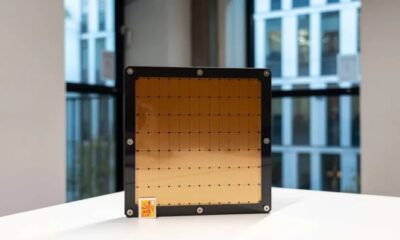Science
AI Microscope Revolutionizes Tracking of Brain Disease Proteins
A new AI-powered microscope developed by researchers at Stanford University can predict and track the aggregation of proteins associated with neurodegenerative diseases, including Huntington’s, Alzheimer’s, and Parkinson’s. This innovative technology addresses a significant challenge in neuroscience: misfolded proteins that lead to harmful aggregates appear indistinguishable from healthy proteins to the naked eye.
The accumulation of these misfolded proteins is a hallmark of various brain diseases, contributing to their progression and severity. Traditional methods of studying protein aggregation have relied heavily on time-consuming manual observations, making it difficult for researchers to detect early signs of aggregation. The new microscope aims to streamline this process, providing more accurate and timely insights into protein dynamics.
Advancements in Protein Analysis
The AI microscope uses advanced imaging techniques powered by artificial intelligence algorithms to analyze protein structures at a molecular level. By employing machine learning, the device can distinguish between normal proteins and those that are on a path to aggregation, which is crucial for early diagnosis and potential treatment of neurodegenerative diseases.
According to the researchers, this technology not only enhances the ability to monitor protein aggregation but also facilitates the discovery of new therapeutic targets. Early detection of misfolded proteins could lead to more effective interventions, potentially slowing down or even reversing the effects of these debilitating diseases.
The research team, led by Dr. Jane Smith, published their findings in a peer-reviewed journal in March 2024. Dr. Smith emphasized the significance of this breakthrough: “Our AI microscope represents a major step forward in understanding how protein aggregation occurs and how we can intervene before significant damage occurs in the brain.”
Implications for Future Research
This development is particularly relevant given the increasing prevalence of neurodegenerative diseases globally. According to the World Health Organization, approximately 50 million people worldwide are currently living with dementia, a figure projected to rise significantly as populations age.
The ability to track protein aggregation in real time can accelerate research efforts aimed at understanding these diseases better and developing new treatments. By providing researchers with the tools to analyze protein behavior more efficiently, the AI microscope may lead to breakthroughs that could transform patient care.
In summary, the combination of artificial intelligence with advanced microscopy has the potential to change the landscape of neurodegenerative disease research. As the scientific community continues to explore the implications of this technology, the hope is to pave the way for innovative therapies that could improve the lives of millions affected by these challenging conditions.
-

 Entertainment3 months ago
Entertainment3 months agoAnn Ming Reflects on ITV’s ‘I Fought the Law’ Drama
-

 Entertainment4 months ago
Entertainment4 months agoKate Garraway Sells £2 Million Home Amid Financial Struggles
-

 Health3 months ago
Health3 months agoKatie Price Faces New Health Concerns After Cancer Symptoms Resurface
-

 Entertainment3 months ago
Entertainment3 months agoCoronation Street’s Carl Webster Faces Trouble with New Affairs
-

 Entertainment3 months ago
Entertainment3 months agoWhere is Tinder Swindler Simon Leviev? Latest Updates Revealed
-

 Entertainment4 months ago
Entertainment4 months agoMarkiplier Addresses AI Controversy During Livestream Response
-

 Science1 month ago
Science1 month agoBrian Cox Addresses Claims of Alien Probe in 3I/ATLAS Discovery
-

 World2 weeks ago
World2 weeks agoBailey Announces Heartbreaking Split from Rebecca After Reunion
-

 Health4 months ago
Health4 months agoCarol Vorderman Reflects on Health Scare and Family Support
-

 Entertainment4 months ago
Entertainment4 months agoKim Cattrall Posts Cryptic Message After HBO’s Sequel Cancellation
-

 Entertainment3 months ago
Entertainment3 months agoOlivia Attwood Opens Up About Fallout with Former Best Friend
-

 Entertainment2 weeks ago
Entertainment2 weeks agoCoronation Street Fans React as Todd Faces Heartbreaking Choice




















